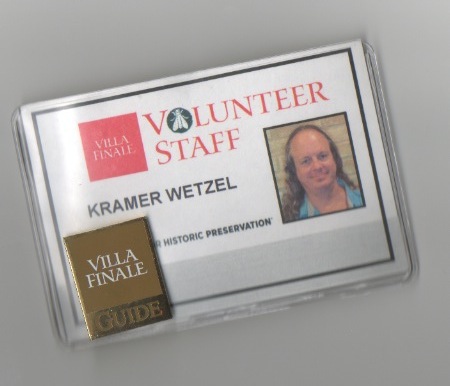Continued from here…
Upstairs…
Turn the corner and there’s another piano, under a display – along the wall – of more South American santos as well as relics gathered in Mexico. Starting in 1910, much of the Catholic church’s hold on the land was released during revolution, and the relics eventually found there way here. There was one intern, summer before the Villa Finale opened, all she did was polish the silver that on top of the upstairs piano.
From the hallway, it’s a left into the Periwinkle Room. The color is available from Lowe’s, just ask for ‘Villa Finale Periwinkle.’
Among artworks and other items, there are two cases of note. Along one wall, there’s a collection of over 300 stick-pins. Walter Mathis got his first stick-pin from his grandmother, and that started his life-long obsession with collections and preservation.
I tend to joke about the stick-pins because, as a tie-tack, it’s something I will never, ever wear again. It’s religious, you know.
Walter Mathis, especially with his huge collection of religious artifacts, he wasn’t a church-goer. He was until his downtown Episcopal Church tore down a historic structure, an old house, historic house, to make way for a parking lot. He resigned and never went to another church. Never looked back, as they say.
There’s a huge assortment of watches and timepieces, but more interesting, to me, is the collection of shaving mugs. Started when he was fifteen, the mugs capture the essence of a time gone by. The mugs are displayed in a pair of custom-built cabinets that were designed to reflect the architecture of his manse. As ephemeral data points, the mugs are marketing from a day gone by, and the shaving mugs differ from, like, a coffee cup, since there is a little shelf for a bar of soap and the shaving brush.
One of the curators worked at a site in California, talked about the importance of the historical value of the shaving mugs.
It’s a two-step into the Yellow Room. Artwork, a throne, stairs to the tower, and a set of columns, rescued from his home in Monte-Vista. There’s an odd collection of Staffordshire figures, and one is more curious, looks like Ben Franklin but it’s labeled, “Geo. Washington.”
Staffordshire ceramics was likely produced by child labor.
Shaving stands, sewing kits, Walter Mathis bemoaned the fact that he was a Victorian, born a hundred years too late.
Tucked against one wall, there’s a set piece that is identical to one in Maximilian’s palace in Mexico City. Another guide posited the connection — downstairs, Napoleon — upstairs, his illegitimate son —
The master of the house, Walter Mathis, in an apparent humorous display, he had a gold cherub with its chubby little butt pointed towards the center of the room.
The valences, over the windows, when the restorer was working, she’d heard that the valences were from a plantation in Mississippi. Or near Houston, never got the straight story on that, but they were removed for the new paint, and it turns out, it was bit of a puzzle to put them back on, as they were different sizes.
Can’t say anything about what’s up in the tower. I wasn’t allowed up there.

Can’t answer any questions about the throne, either. No idea.
The sketch up on the wall is an Edouard Leon study of a Mounet (?) — best part of that? It was a ‘lady of substance,’ and that caused quite the scandal. A ‘lady of substance’ wasn’t supposed to pose for a common artist’s works.
Back into the hall, and it’s painter time. One of the most exquisite paintings is one of the Onerdonk’s of Prickly Pear in Bloom. Seen it live, and the picture, all last winter, reminded me of what we could all look forward to — cactus in bloom. Brilliant shower of flower color agains the Texas skies.
There’s another painting, at the bottom, and it’s one of the few that was done while Onerdonk was in studying in New York, mentioned in his letters. There are the usual amazing bluebonnet paintings, too. What he was a famous for.
There’s one painting, inscribed to Walter Mathis’s mother, ‘From a little friend, to a little friend, in a little friendly way.’
Passing around the corner is another bedroom, there’s a wooden-press. Flower press? Probably a blanket press, since there’s was a strong tie with Rockport, and the Rockport Quilt Guild.
South of San Antonio, on Interstate 37, right before entering the coastal port of Corpus Christi, the highway passes through Mathis, TX. Same Mathis family, there’s still a Mathis House, and the family had a hand in restoring the historical Fulton Mansion, in Rockport, yes, it should be in Fulton, but no, it’s not.
The small bedroom has his parents’ wedding bed. It came from St. Louis, down the Mississippi River, where it was loaded on another’s boat and delivered to Rockport. According to the myth, one or more of his brothers and/or sisters was born in that bed.
More interesting, though, is the array of the family tree, mother on the right side, father n the left, tracing back through the generations.
In the front room, visible from the bedroom, has an array of Victorian memorabilia, Bristol Glass, a peacock, beaded purses, antique calling cards and Victorian card clips. There is a large carved ivory ‘china’ boat, and an allegedly working Victrola, hand=crank type of record player.
During the great flood of 2007, this room suffered water damage. Like many men of similar vintage, Mr. Mathis insisted on doing his own maintenance, and that suffered towards the end. Hence the water damage.
Back in the hall, opposite from the piano, there’s a large sideboard with a glass front. It’s ‘Century Glass,’ souvenir glass from the St. Louis worlds fair, circa, 1904. Another grandmother gift. The collection was embellished when the McNay (museum) asked to display it. Walter collected some more, just to make sure the museum had an adequate presentation.
Around the corner is a bathroom — passing a small glass case with another selection of naughty clock faces, slightly ‘PG’ by modern standards, but risqué by pre-modern mores.
Step into Walter Mathis’s bedroom. Although he lived downtown at a hotel, during his renovation, he eventually moved into this bedroom, over the kitchen. The wallpaper was vinyl, faux-linen, and it peeled off with that water damage. During the National Trust’s restoration, a chance encounter yielded up some of the matching wallpaper.
Much of the artwork in his bedroom is from an engraver named ‘Currier,’ as in, ‘Currier and Ives,’ before there was an Ives. Much of the Currier art is from the Mexican-American War (1842 – marched as far as Mexico City).
Walters Mathis was proud of his Texas heritage.
Many of the quilts are Christmas themed, as Walter passed in December, it was his wish that the house be preserved just as he left it.
A four-thousand square foot mansion stuffed with art, the common assumption is that he inherited wealth. His family lost it all in the Great Depression, and Walter Mathis did this on his own. Never married, but he was engaged, at least twice, which might be part of it, but the larger part was he was one of the youngest members of the New York Stock Exchange, after the war, and as an investment banker, his biggest win was brokering the Pepsi-Frito Lay deal. Towards that end, his favorite drink was rum and Cherry Pepsi, while he never allowed coke products in the house.
Beyond the bedroom, there’s sitting room, complete with a kitchenettes installed for him. Along one wall, there’s a selection of Texan currency, bills from the Republic of Texas. I point out, that, in London, there’s a small plaque, designating where the Texas Legate was, 1842-1845.
There are a number of Texas maps along one of the walls, one of which is a favorite as it shows the western border of the great state of Texas to be the Rio Grande, and that map includes the headwaters of the Rio Grande — all the way to Canada.
The real prize, in my eyes, is the T. Gentilz. Already mentioned in a horoscope (Cancer), I pointed out that Castroville, founded by Henry Castro, from Alsace-Lorraine (France).
T. Gentilz was a surveyor, working for Henri Castro. As such, T. Gentilz would travel between Castroville and San Antonio, taking about three days to complete the journey. He would stop along the way and sketch, draw, paint local color. There are several completed painting, one that seems incomplete, one art historian insists it’s the ‘queen’ of the San Antonio missions, San Jose.
I’m pretty sure it’s Concepcion de la Purissima.
There is another painting, part of the collection, but to an unlettered and untutored eye, the style and execution is so different, I’m inclined to believe it was a forgery or fake. One local art historian, who knew Walter, suggested that Walter knew it was a fake, but loudly insisted it wasn’t. Oral tradition versus real provenance.
The door that leads to the back porch also leads to back stairs. Included in this flight is a short set of step that lead to some kind of cabinet, or sewing nook. Top of the flight of stairs, there is a collection of circus figures, probably porcelain, and another allegedly working phonograph, the Edison variety with a clearly visible hand-crank and wax cylinder for the recording.
Down the stairs, it’s a narrow staircase, certainly not ADA-compliant, and potentially dangerous for the loose carpets, there is the most magnificent collection of paintings and prints.
The bulk of the collection, from what I’ve gathered, came from the purchase of the Mary Bonner Estate. What I was told, Mary Bonner went to Paris to study painting, and one teacher told her that she din’t have the strength to be a painter so she should look at print-making instead.
Relying on her native San Antonio background, her prints of cowboys and similar Texas-themes became the toast of France.
It happens. They love Texans. You do know, Texas is bigger than France?
The Mary Bonner collection, alone it that back stairwell is enough to render the whole trip worthwhile.
There are several sketches of the missions, again, later Mary Bonner works.
The stairs unwind into the kitchen. This was a working kitchen. Rumor has it, the refrigerator still has frozen foods, left over from before the Historic Trust took over.
There’s all kinds of flatware, cookware, Wedge Wood, and China. The story is, one plate was used for serving until Walter Mathis found out the value of the platter. Now on the wall.
The woodwork itself was rescued and repurposed from the Sullivan House, another casualty in San Antonio’s growth.
Because it was a real, working kitchen, the spices that were “pretty,” and had “eye-appeal,” those spices were displayed. The shuttered cupboard, now and office, held the unattractive spices. There are jars of pasta and candy, sweets and so forth, and they haven’t been changed, at least not yet. Probably won’t be touched, looks fine, seems preserved.
The chandelier in the kitchen, kind of a hideous pastiche of glazed, colored glass, wood and brass? The story is, it was in the front room, originally. Walter Mathis had taken it to a consignment shop, and some guy offered him $500, on the spot, for the chandelier. When queried why, Walter was going to sell it for $50, these are 1969 Dollars, so that was a great deal of money, then the prospective buyer pointed out that the lamp, chandelier, was signed by Tiffany. A real Tiffany Lamp.
(Provenance on this is suspect, too. Very suspect.)
It now hangs high overhead in the kitchen.
Adjacent to the kitchen is the Butler’s Pantry, with a full wet-bar, the wood work more of the rescued cabinetry.
Finally, the Pewter Room. At this point, I’m out of energy, having talked for the better part of 45 minutes or so, and quite tired. Pewter Room. Lots of pewter on the shelf, beer steins, and the Rhine Maiden.
Another gloriously hideous chandelier, actually, an antique Bier Garten. candelabra, from the old country. Came from a German Saloon with German immigrants, perhaps a little before the Villa Finale was built. By the turn of the century, it wound up at the Buckhorn Saloon, open during Prohibition, to make it’s way to Walter’s back den. Ride of the Valkyries? Yes, that kind of Rhine Maiden, cf., Wagner’s Ring Cycle, first and last opera. She was supposed to guard the gold in the Rhine.
The other bizarre piece is a very art nouveau lamp. The threesome. Kind of hard to tell, but looks like two naked women intertwined with a single topless guy. Story was, he bought this as a tabletop lamp, and at close to five or six feet tall, it doesn’t really set well on a tabletop, but that’s what it is now.
Out the back door, onto the back porch. It’s easy to see, while getting off the booties, where the new stuff had been added on the original building. Underneath the back portion, a cellar was added.
One of the owners, owned the Casino when it was located n downtown San Antonio, and when the Prohibition hit, moved his operation to his cellar. Unverified. Gambling operations, bawdy house, speakeasy, all by reputation, but not substantiating facts support the allegations.
Once the booties are off, there’s a small arc around the building Walter Mathis’s ashes are interred under a small flag, the small gatehouse and the big carriage house serves as onsite offices for some, plus a bathroom and lockers for over-sized purses.
The original plan for this section of the RiverWalk was to carve through the Villa Finale property, imminent domain and all. Mr. Mathis, as a civic leader and patron of the arts, fought city hall — and won. Look a the aerial plat, and the river’s course bends around his property.
There are three friezes, set in the southern wall, borders the property. Same artist as the Cenotaph for the Alamo, downtown.
The tour concludes in the wrought-iron gazebo, cupola. Walter’s neice was married there, in the spring of 1970, and the hose has been, like a museum, ever since.
Family members have toured Villa Finale, and the most common comment, “Wow, just like he left it, except now, everything is so clean….”

